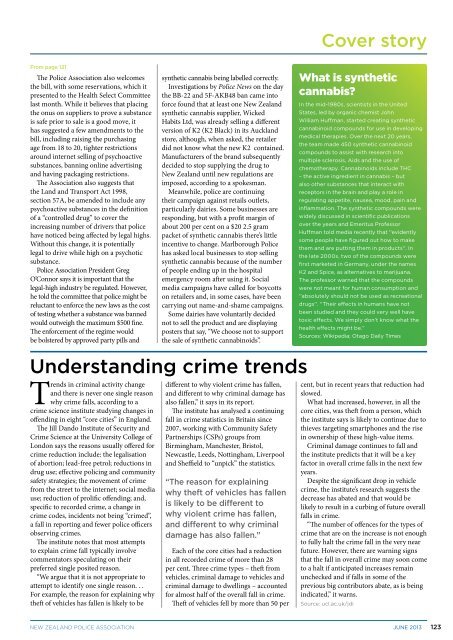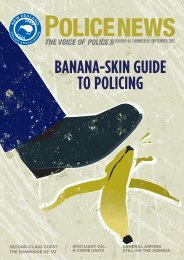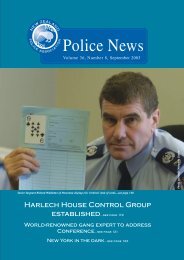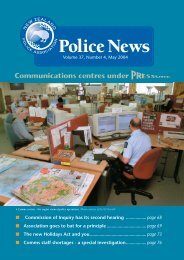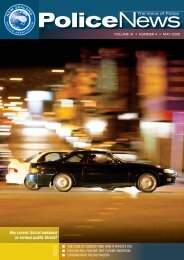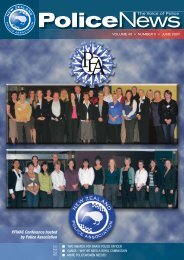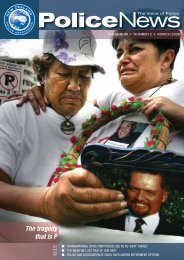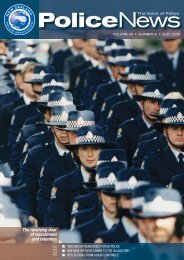FAKE dOPE REAl TROublE - New Zealand Police Association
FAKE dOPE REAl TROublE - New Zealand Police Association
FAKE dOPE REAl TROublE - New Zealand Police Association
You also want an ePaper? Increase the reach of your titles
YUMPU automatically turns print PDFs into web optimized ePapers that Google loves.
Cover storyFrom page 121The <strong>Police</strong> <strong>Association</strong> also welcomesthe bill, with some reservations, which itpresented to the Health Select Committeelast month. While it believes that placingthe onus on suppliers to prove a substanceis safe prior to sale is a good move, ithas suggested a few amendments to thebill, including raising the purchasingage from 18 to 20, tighter restrictionsaround internet selling of psychoactivesubstances, banning online advertisingand having packaging restrictions.The <strong>Association</strong> also suggests thatthe Land and Transport Act 1998,section 57A, be amended to include anypsychoactive substances in the definitionof a “controlled drug” to cover theincreasing number of drivers that policehave noticed being affected by legal highs.Without this change, it is potentiallylegal to drive while high on a psychoticsubstance.<strong>Police</strong> <strong>Association</strong> President GregO’Connor says it is important that thelegal-high industry be regulated. However,he told the committee that police might bereluctant to enforce the new laws as the costof testing whether a substance was bannedwould outweigh the maximum $500 fine.The enforcement of the regime wouldbe bolstered by approved party pills andsynthetic cannabis being labelled correctly.Investigations by <strong>Police</strong> <strong>New</strong>s on the daythe BB-22 and 5F-AKB48 ban came intoforce found that at least one <strong>New</strong> <strong>Zealand</strong>synthetic cannabis supplier, WickedHabits Ltd, was already selling a differentversion of K2 (K2 Black) in its Aucklandstore, although, when asked, the retailerdid not know what the new K2 contained.Manufacturers of the brand subsequentlydecided to stop supplying the drug to<strong>New</strong> <strong>Zealand</strong> until new regulations areimposed, according to a spokesman.Meanwhile, police are continuingtheir campaign against retails outlets,particularly dairies. Some businesses areresponding, but with a profit margin ofabout 200 per cent on a $20 2.5 grampacket of synthetic cannabis there’s littleincentive to change. Marlborough <strong>Police</strong>has asked local businesses to stop sellingsynthetic cannabis because of the numberof people ending up in the hospitalemergency room after using it. Socialmedia campaigns have called for boycottson retailers and, in some cases, have beencarrying out name-and-shame campaigns.Some dairies have voluntarily decidednot to sell the product and are displayingposters that say, “We choose not to supportthe sale of synthetic cannabinoids”.What is syntheticcannabis?In the mid-1980s, scientists in the UnitedStates, led by organic chemist JohnWilliam Huffman, started creating syntheticcannabinoid compounds for use in developingmedical therapies. Over the next 20 years,the team made 450 synthetic cannabinoidcompounds to assist with research intomultiple sclerosis, Aids and the use ofchemotherapy. Cannabinoids include THC– the active ingredient in cannabis – butalso other substances that interact withreceptors in the brain and play a role inregulating appetite, nausea, mood, pain andinflammation. The synthetic compounds werewidely discussed in scientific publicationsover the years and Emeritus ProfessorHuffman told media recently that ''evidentlysome people have figured out how to makethem and are putting them in products''. Inthe late 2000s, two of the compounds werefirst marketed in Germany, under the namesK2 and Spice, as alternatives to marijuana.The professor warned that the compoundswere not meant for human consumption and''absolutely should not be used as recreationaldrugs''. ''Their effects in humans have notbeen studied and they could very well havetoxic effects. We simply don’t know what thehealth effects might be.”Sources: Wikipedia; Otago Daily TimesUnderstanding crime trendsTrends in criminal activity changeand there is never one single reasonwhy crime falls, according to acrime science institute studying changes inoffending in eight “core cities” in England.The Jill Dando Institute of Security andCrime Science at the University College ofLondon says the reasons usually offered forcrime reduction include: the legalisationof abortion; lead-free petrol; reductions indrug use; effective policing and communitysafety strategies; the movement of crimefrom the street to the internet; social mediause; reduction of prolific offending; and,specific to recorded crime, a change incrime codes, incidents not being “crimed”,a fall in reporting and fewer police officersobserving crimes.The institute notes that most attemptsto explain crime fall typically involvecommentators speculating on theirpreferred single posited reason.“We argue that it is not appropriate toattempt to identify one single reason. . .For example, the reason for explaining whytheft of vehicles has fallen is likely to bedifferent to why violent crime has fallen,and different to why criminal damage hasalso fallen,” it says in its report.The institute has analysed a continuingfall in crime statistics in Britain since2007, working with Community SafetyPartnerships (CSPs) groups fromBirmingham, Manchester, Bristol,<strong>New</strong>castle, Leeds, Nottingham, Liverpooland Sheffield to “unpick” the statistics.“The reason for explainingwhy theft of vehicles has fallenis likely to be different towhy violent crime has fallen,and different to why criminaldamage has also fallen.”Each of the core cities had a reductionin all recorded crime of more than 28per cent. Three crime types – theft fromvehicles, criminal damage to vehicles andcriminal damage to dwellings – accountedfor almost half of the overall fall in crime.Theft of vehicles fell by more than 50 percent, but in recent years that reduction hadslowed.What had increased, however, in all thecore cities, was theft from a person, whichthe institute says is likely to continue due tothieves targeting smartphones and the risein ownership of these high-value items.Criminal damage continues to fall andthe institute predicts that it will be a keyfactor in overall crime falls in the next fewyears.Despite the significant drop in vehiclecrime, the institute’s research suggests thedecrease has abated and that would belikely to result in a curbing of future overallfalls in crime.“The number of offences for the types ofcrime that are on the increase is not enoughto fully halt the crime fall in the very nearfuture. However, there are warning signsthat the fall in overall crime may soon cometo a halt if anticipated increases remainunchecked and if falls in some of theprevious big contributors abate, as is beingindicated,” it warns.Source: ucl.ac.uk/jdinew zealand police aSSOCIATION june 2013 123


